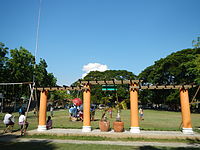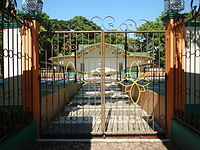Anao, Tarlac
Anao | |
|---|---|
| Municipality of Anao | |
 Municipal Hall | |
 Map of Tarlac with Anao highlighted | |
Location within the Philippines | |
| Coordinates: 15°43′49″N 120°37′35″E / 15.730386°N 120.626414°E | |
| Country | Philippines |
| Region | Central Luzon |
| Province | Tarlac |
| District | 1st district |
| Founded | March 16, 1870 |
| Barangays | 18 (see Barangays) |
| Government | |
| • Type | Sangguniang Bayan |
| • Mayor | Gian Pierre O. De Dios |
| • Vice Mayor | Jocelyn C. Punzalan |
| • Representative | Jaime D. Cojuangco |
| • Municipal Council | Members |
| • Electorate | 9,050 voters (2022) |
| Area | |
| • Total | 23.87 km2 (9.22 sq mi) |
| Elevation | 21 m (69 ft) |
| Highest elevation | 34 m (112 ft) |
| Lowest elevation | 15 m (49 ft) |
| Population (2020 census)[3] | |
| • Total | 12,208 |
| • Density | 510/km2 (1,300/sq mi) |
| • Households | 3,089 |
| Economy | |
| • Income class | 5th municipal income class |
| • Poverty incidence | 11.99 |
| • Revenue | ₱ 77.1 million (2020) |
| • Assets | ₱ 163.9 million (2020) |
| • Expenditure | ₱ 75 million (2020) |
| • Liabilities | ₱ 21.83 million (2020) |
| Service provider | |
| • Electricity | Tarlac 1 Electric Cooperative (TARELCO 1) |
| Time zone | UTC+8 (PST) |
| ZIP code | 2310 |
| PSGC | |
| IDD : area code | +63 (0)45 |
| Native languages | Pangasinan Ilocano Tagalog Kapampangan |
| Website | anaotarlac |
Anao, officially the Municipality of Anao (Pangasinan: Baley na Anao; Template:Lang-ilo; Tagalog: Bayan ng Anao), is a 5th class municipality in the province of Tarlac, Philippines. According to the 2020 census, it has a population of 12,208 people.[3]
The smallest town in terms of land area in the whole of Tarlac, Anao covers a total land area of 23.87 square kilometres (2,387 ha).
Formerly a part of Pangasinan province, Anao was founded and organized into a municipality on March 16, 1870. Every year on the March 16, the foundation of the town is celebrated along with the Ylang-Ylang Festival.
Geography
Anao is 34 kilometres (21 mi) east of the provincial capitol and nestling on the Tarlac-Nueva Ecija border. Located in the north-eastern part of Tarlac, it is bound on the north by San Manuel, in the east by Nampicuan, on the south by Ramos and on the west by Paniqui and Moncada.
Barangays
Anao is politically subdivided into 18 barangays. [5]
Climate
| Climate data for Anao, Tarlac | |||||||||||||
|---|---|---|---|---|---|---|---|---|---|---|---|---|---|
| Month | Jan | Feb | Mar | Apr | May | Jun | Jul | Aug | Sep | Oct | Nov | Dec | Year |
| Mean daily maximum °C (°F) | 30 (86) |
31 (88) |
33 (91) |
35 (95) |
33 (91) |
31 (88) |
30 (86) |
29 (84) |
29 (84) |
30 (86) |
31 (88) |
30 (86) |
31 (88) |
| Mean daily minimum °C (°F) | 19 (66) |
19 (66) |
20 (68) |
22 (72) |
24 (75) |
24 (75) |
24 (75) |
24 (75) |
23 (73) |
22 (72) |
21 (70) |
20 (68) |
22 (71) |
| Average precipitation mm (inches) | 3 (0.1) |
2 (0.1) |
5 (0.2) |
10 (0.4) |
80 (3.1) |
107 (4.2) |
138 (5.4) |
147 (5.8) |
119 (4.7) |
70 (2.8) |
26 (1.0) |
8 (0.3) |
715 (28.1) |
| Average rainy days | 2.0 | 1.7 | 2.7 | 4.6 | 16.1 | 20.8 | 24.0 | 23.0 | 21.4 | 15.5 | 8.0 | 3.2 | 143 |
| Source: Meteoblue[6] | |||||||||||||
Demographics
| Year | Pop. | ±% p.a. |
|---|---|---|
| 1903 | 3,678 | — |
| 1918 | 3,314 | −0.69% |
| 1939 | 3,486 | +0.24% |
| 1948 | 4,453 | +2.76% |
| 1960 | 5,068 | +1.08% |
| 1970 | 6,672 | +2.78% |
| 1975 | 6,084 | −1.83% |
| 1980 | 6,519 | +1.39% |
| 1990 | 7,955 | +2.01% |
| 1995 | 9,240 | +2.85% |
| 2000 | 10,045 | +1.81% |
| 2007 | 10,806 | +1.01% |
| 2010 | 10,873 | +0.23% |
| 2015 | 11,528 | +1.12% |
| 2020 | 12,208 | +1.13% |
| Source: Philippine Statistics Authority[7][8][9][10] | ||
In the 2020 census, the population of Anao, Tarlac, was 12,208 people,[3] with a density of 510 inhabitants per square kilometre or 1,300 inhabitants per square mile.
Anao is predominantly an Ilocano-speaking town although most are fluent in Tagalog. Other languages like Kapampangan and Pangasinan are spoken by about 10% of the population.
Aglipayan and Roman Catholicism are two of the predominant religions in the municipality. Other groups having a large number of members in the municipality are the Church of Jesus Christ of Latter-day Saints, Iglesia ni Cristo, and Protestantism.
Economy
Poverty incidence of Anao
5
10
15
20
2006
13.90 2009
17.99 2012
9.75 2015
10.45 2018
5.21 2021
11.99 Source: Philippine Statistics Authority[11][12][13][14][15][16][17][18] |
History
The area where Anao is located was inhabited before 1800 by people from the Ilocos Region. In 1835, a group of immigrants from Paoay, Ilocos Norte reached the region and first settled near a creek on the bank where there were balete trees. These immigrants called their settlement Balete. The immigrants found the region where they settled to have many agricultural prospects and this attracted more immigrants who came from the north, especially from the town of Paoay.
The settlement expanded and later changed its name to "Barrio Anao" (deriving authentically from the Ilocano word danao which means creek and due to the anahao leaf that grows in various area they derive the name Anao). By that time, balete trees were extinguished and the barrio was adjacent in all directions by creeks.
Paniqui had a road extended towards the east to Anao. Paniqui claimed Anao as its barrio and the people of the barrio accepted the claim. Years went by and Anao expanded. In 1870, a petition was made and approved that Anao be made a municipality.[citation needed]
Past mayors
| Name | Term Began | Term Ended |
|---|---|---|
| Ramon Evangelista | 1938 | 1946 |
| Arcadio Evangelista | 1946 | 1947 |
| Silvestre Sabado | 1948 | 1951 |
| Arcadio Evangelista | 1952 | 1955 |
| Dionisio Dumlao | 1960 | 1963 |
| Catalino O. Cruz | 1964 | 1979 |
| Andres Dela Cruz | 1979 | 1986 |
| Clemente T. Apuan | 1988 | 1998 |
| Rodolfo F. Guerrero | 1998 | 2007 |
| Edgardo S. Felipe | 2007 | 2016 |
| Betty B. Lacbayan | 2016 | 2019 |
| Rafael M. Naral | 2019 | 2022 |
| Gian Pierre O. De Dios | 2022 | Incumbent |
Points of interest
The Saint John Nepomucene Parish Church of Anao[19] can be found on the center of the town near the municipal hall. It belongs to the Roman Catholic Diocese of Tarlac.[20]
The Ylang Ylang Festival is celebrated by the municipality every 16 March to take pride of their main local products, which are perfumes and essentials oils made from the ylang-ylang flower.[21] The town has over 10,000 ylang-ylang trees, many of them lined on the local main road, which are harvested and highly valued for its perfume.[22]
Gallery
-
Saint John Nepomucene Parish Church of Anao
-
Ylang-ylang trees line all the streets
-
Multi Purpose Covered Court
-
Iglesia Filipina Independiente Church
-
Anao Municipal Building
-
Municipal Open Field
-
Municipal Auditorium
-
Barangay Bantog ARC
-
Anao, Welcome ARC at Barangay San Francisco West
References
- ^ Municipality of Anao | (DILG)
- ^ "2015 Census of Population, Report No. 3 – Population, Land Area, and Population Density" (PDF). Philippine Statistics Authority. Quezon City, Philippines. August 2016. ISSN 0117-1453. Archived (PDF) from the original on May 25, 2021. Retrieved July 16, 2021.
- ^ a b c Census of Population (2020). "Region III (Central Luzon)". Total Population by Province, City, Municipality and Barangay. Philippine Statistics Authority. Retrieved 8 July 2021.
- ^ "PSA Releases the 2021 City and Municipal Level Poverty Estimates". Philippine Statistics Authority. 2 April 2024. Retrieved 28 April 2024.
- ^ "Province: Tarlac". PSGC Interactive. Quezon City, Philippines: Philippine Statistics Authority. Retrieved 12 November 2016.
- ^ "Anao: Average Temperatures and Rainfall". Meteoblue. Retrieved 5 May 2020.
- ^ Census of Population (2015). "Region III (Central Luzon)". Total Population by Province, City, Municipality and Barangay. Philippine Statistics Authority. Retrieved 20 June 2016.
- ^ Census of Population and Housing (2010). "Region III (Central Luzon)" (PDF). Total Population by Province, City, Municipality and Barangay. National Statistics Office. Retrieved 29 June 2016.
- ^ Censuses of Population (1903–2007). "Region III (Central Luzon)". Table 1. Population Enumerated in Various Censuses by Province/Highly Urbanized City: 1903 to 2007. National Statistics Office.
- ^ "Province of Tarlac". Municipality Population Data. Local Water Utilities Administration Research Division. Retrieved 17 December 2016.
- ^ "Poverty incidence (PI):". Philippine Statistics Authority. Retrieved December 28, 2020.
- ^ "Estimation of Local Poverty in the Philippines" (PDF). Philippine Statistics Authority. 29 November 2005.
- ^ "2003 City and Municipal Level Poverty Estimates" (PDF). Philippine Statistics Authority. 23 March 2009.
- ^ "City and Municipal Level Poverty Estimates; 2006 and 2009" (PDF). Philippine Statistics Authority. 3 August 2012.
- ^ "2012 Municipal and City Level Poverty Estimates" (PDF). Philippine Statistics Authority. 31 May 2016.
- ^ "Municipal and City Level Small Area Poverty Estimates; 2009, 2012 and 2015". Philippine Statistics Authority. 10 July 2019.
- ^ "PSA Releases the 2018 Municipal and City Level Poverty Estimates". Philippine Statistics Authority. 15 December 2021. Retrieved 22 January 2022.
- ^ "PSA Releases the 2021 City and Municipal Level Poverty Estimates". Philippine Statistics Authority. 2 April 2024. Retrieved 28 April 2024.
- ^ Category:Saint John Nepomucene Parish Church of Anao - Wikimedia Commons
- ^ Diocese of Tarlac, Philippines
- ^ "This Week's Festivals: March 10-16, 2019". Philippine Daily Inquirer. Quezon City. 10 March 2019. Retrieved 8 May 2019.
"Ylang-Ylang Festival". Municipality of Anao. 2019. Retrieved 8 May 2019. - ^ Fernandez, Rudy (1 October 2009). "Tarlac's smallest town a big dot in global perfumery industry map". The Philippine Star. Tuguig City. Retrieved 8 May 2019.













